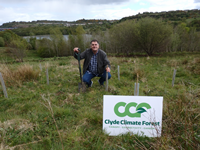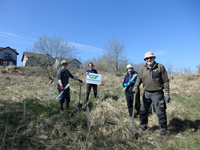Partner Press Release: Plans to plant 10 trees for every person in Glasgow City Region
Over the next decade, 10 trees for every man, woman and child in Glasgow City Region, including Inverclyde, will be planted as part of a new urban ‘forest’ to tackle climate change.
The ambitious planting pledge lies at the heart of the new Clyde Climate Forest, which is part of the Glasgow & Clyde Valley Green Network, and will breathe new life across the eight local authorities in the region.
Around 18 million trees will be planted over the next decade, increasing woodland cover in the region from 17% to 20%.
The move is being viewed as an ideal opportunity for Glasgow City Region to demonstrate its commitment to reaching Net Zero, as it hosts COP26 in November.
In Inverclyde, trees are being planted at Coves Nature Reserve on the border between Greenock and Gourock - the first of many projects across the district where planting will take place.
Council leader, Councillor Stephen McCabe, led the way along with volunteers from the Friends of Coves Community Nature Reserve group in planting the first saplings.

Councillor Stephen McCabe, Leader of Inverclyde Council, said: “We’re in a climate emergency and we must do all we can to protect our planet.
“The Clyde Climate Forest initiative is a simple but effective way of using trees and nature to help reduce CO2 in the atmosphere and produce cleaner air.
“We’re fortunate in Inverclyde to have so many wonderful green spaces like the Coves Nature Reserve but we can always do more and that’s why I’m delighted Inverclyde is part of this project, which complements the ongoing efforts of the council, the people across our area and the wider Glasgow City Region to reduce our carbon footprint.”
Councillor Andrew Polson, Joint Leader of East Dunbartonshire Council and Chair of the Land Use and Sustainability Portfolio for Glasgow City Region, said:
“Trees are nature’s own green lungs, improving the air that we breathe and soaking up harmful CO2 emissions from our environment. Expanding Glasgow City Region’s woodlands to create a new inter-connected forest will provide many lasting benefits.
“There are opportunities for communities, schools, businesses and landowners to get involved in our planting mission. We all have a fantastic opportunity to work collectively to improve our living environment whilst tackling climate change at the same time.”
There are around 29,000 hectares of broadleaved woodland in the region, but they are fragmented due to urban development. The new planting aims to connect these woodlands and help restore nature and boost biodiversity.
Welcoming the launch of the Clyde Climate Forest, Mairi McAllan, Minister for Environment, Biodiversity and Land Reform said:
“This is a significant and well timed initiative showcasing all that is good in tree planting as we approach COP26. It is also a first for Scotland, with eight local authorities working together with government and other partners on a major woodland creation initiative.
“Tree planting is key to tackling the twin crises of climate change and biodiversity loss and there is tremendous support for it across Scotland. The Clyde Climate Forest taps into this and the benefits will last for generations.”
Working to the principle of ‘the right tree in the right place’, the project team aims to plant trees in areas of deprivation, former coalmining sites, vacant and derelict land, urban streets and other civic places.
As part of the long-term plans, the project team at Clyde Climate Forest is calling on community groups and land managers to help them identify places to plant new trees, or replace ones that have been lost in the past.
Work is also beginning to encourage smaller land owners and local authorities to gear up for tree planting. They are being offered free woodland assessments to help them identify potential new areas to be greened up with trees.
Launching the initiative Councillor Aitken, Chair of Glasgow City Region Cabinet and Leader of Glasgow City Council, added: “This year we have an opportunity to shine a spotlight on Glasgow City Region and showcase how we are planning to adapt to and mitigate climate change while allowing nature to thrive and grow.
“New community woodlands, trees and forests will bring multiple benefits to our local communities as well as wildlife. The pandemic has brought into focus like never before the value of local spaces as places to exercise, de-stress and engage with nature and this project can help to deliver the Green Recovery.
“The economic, ecological and social benefits will be extensive.”
As part of corporate social responsibility commitments, businesses within Glasgow City Region are being encouraged to get their staff involved with community tree planting projects.
Businesses and other organisations can invest in the Clyde Climate Forest if they sign up to a new charter which demonstrates their commitment to reducing emissions across their business supporting the fight against climate change.
The majority of woodland planting will be funded through Scottish Forestry’s various grant schemes but also through funding mechanisms that the Clyde Climate Forest can lever. Community groups and individuals can also donate.
Dave Signorini, Chief Executive of Scottish Forestry said:“The Clyde Climate Forest will deliver social and economic benefit to the population of the City Region. It will also provide a place for nature to connect, recover and thrive.
“Planting trees can help us reduce our carbon footprint and strengthen communities. Scottish Forestry is always ready to advise on the range of forestry grants that are on offer so that we can collectively get more trees in the ground.”
The project secured a £400,000 grant from the Woodland Trust’s Emergency Tree Fund as well as £150,000 from Scottish Forestry over the next two years to recruit a project team and kick-start the development of new planting schemes.
The Clyde Climate Forest is being delivered as part of the Glasgow & Clyde Valley Green Network, with support from Green Action Trust, TCV, Glasgow City Region, Trees for Cities, Scottish Forestry and Woodland Trust Scotland.
Individuals and community groups can donation to the Clyde Climate Forest project through www.mypark.scot/ccf.
For business donations contact business@clydeclimateforest.co.uk
www.clydeclimateforest.co.uk
- The GCV Green Network Partnership was formed in June 2007. The Partnership brings together the eight regional authorities (East Dunbartonshire, East Renfrewshire, Glasgow City, Inverclyde, North Lanarkshire, Renfrewshire, South Lanarkshire and West Dunbartonshire) as well as Scottish Forestry, SEPA, Nature Scotland, the Glasgow Centre for Population Health and Public Health Scotland.
- The GCV Green Network’s blueprint identifies the need for both a strategic access network (of off-road green routes) and a strategic habitat network (of joined up places for nature) of which the Clyde Climate Forest is a part.

- Inverclyde project: Native woodland planting at Coves Nature Reserve on the border between Greenock and Gourock. Coves Nature Reserve sits high above the waterfront next to Inverclyde Royal Hospital. The reserve has two reservoirs that once supplied the residents of Gourock with water and also has Second World War gun emplacements that protected the Clyde from bombing. Coves is a wildlife haven due to the mix of habitats including woodland, grassland, wetland and open water, and is well used by local people. It also has a very active community group who undertake conservation work and litter picks. The group was originally set up by The Conservation Volunteers as part of their Green Gym programme but has continued under its own steam since that programme ended.
The recent planting was undertaken by the community volunteers with some assistance from TCV, who also supplied the trees through their corporate sponsorship programme (OVO Energy).
Area/number trees: 600 trees.
Partners TCV did the planting with the community group and they have supplied the trees through corporate sponsorship.